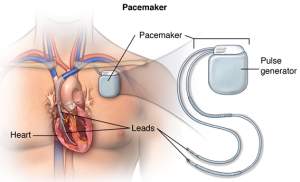

MedFriendly®


Pacemaker
A pacemaker is a device that tracks the heartbeat and
causes it to beat at a normal, rhythmic, predetermined
rate after releasing small electrical discharges.
WHY ARE PACEMAKERS USED?
Normally, the heartbeat is started by electrical signals
in the heart produced by small masses of tissue called
the sinoatrial (SA) and atrial ventricular (AV) nodes.
FEATURED BOOK: Braunwald's Heart Disease: Cardiovascular Medicine
In heart conditions, the heart rhythms may be abnormal and need help becoming normal
again. Pacemakers are used to make the heartbeat normally when it detects a life-
threatening heart rhythm. The life threatening heart rate may be too slow (known as
bradycardia) or too fast (known as tachycardia). Pacemakers are used to correct
bradycardia and tachycardia. When physical activity increases, pacemakers
automatically detect this and increase the heart rate accordingly.
ARE THERE TEMPORARY PACEMAKERS?
Yes. There are several types of temporary pacemakers. One type is connected to the
heart through wires (known as leads) that are threaded through a cathether (flexible,
hollow tube) inserted into a vein from the neck, arm, groin, or chest. Another type can be
directly attached to the heart during surgery and removed afterwards.
"Where Medical Information is Easy to Understand"™
In an emergency, a third type of pacemaker connects a power
source to the chest with two large pads on the chest and back. The
power source makes the heartbeat by sending small charges of
electricity through the pads to the heart.
WHAT ABOUT PERMANENT PACEMAKERS?
Permanent pacemakers are placed in the wall of the chest to control
the heartbeat for years. Although it sounds major, the surgery for
implanting a pacemaker (known as endocardial implantation) is
actually considered mild.
Local anesthesia is used, a small incision is made under the collarbone (usually the left), and a pocket for
the pacemaker is surgically created under the skin and fat. The wires from the pacemaker are threaded
through a vein in the chest until they reach the right atrium or right ventricle of the heart, or both. An atrium
is a chamber on the top of the heart whereas a ventricle is a chamber on the bottom of the heart. The
incision is closed with stitches. The entire procedure takes approximately one hour. Healing takes about 2
to 3 weeks.
HOW LONG DO PACEMAKERS LAST?
Permanent pacemakers run on lithium batteries, which last between 5 and 10 years. Lithium is the lightest
type of metal.
ARE COMPLICATIONS WITH PACEMAKERS COMMON?
No. Complications with pacemakers are rare and when they do occur, usually mild (e.g., bleeding,
infection). A more serious complication is a collapsed lung. However, these complications can usually be
treated quite effectively. Although pacemakers have been known to stop functioning prematurely, this is
why frequent check-ups at the doctor's office are important (see below)
WHAT TYPE OF FOLLOW-UP IS REQUIRED FOR PEOPLE WITH PACEMAKERS?
After permanent pacemaker placement, the person goes for follow-up doctors visits every 3 to 6 months
or 6 to 12 months. This allows the functioning of the device to be checked with a special radio transmitter
and for programming changes to be made. Information from the pacemaker can also be transmitted by
telephone with a special device. If the batteries weaken or the pacemaker fails, it can easily be replaced.
ARE THERE SPECIAL PRECAUTIONS PEOPLE WITH PACEMAKERS MUST TAKE?
Yes. Magnetic resonance imaging scans, and other sources of strong electromagnetic fields need to be
avoided as they will stop pacemakers from working. MRI scans produce extremely detailed pictures of the
inside of the body by using very powerful magnets and computer technology. An electromagnetic field is a
region around a magnet where the force of that magnet and the force of electricity can be felt. Besides
MRI, other sources of strong electromagnetic magnets/fields include running car engines, metal detectors,
and junkyards.
People with pacemakers must be careful to avoid contact sports such as football and hockey. People with
pacemakers who hunt need to be cautious because rifles or shotguns can interfere with pacemaker
functioning if fired when held against the shoulder, close to the pacemaker.
DO MICROWAVES OR CELL PHONES INTERFERE WITH PACEMAKER FUNCTIONG?
Microwaves and cell phones do not interfere with pacemaker functioning, provided the person keeps more
than 6 inches a way from these devices.















